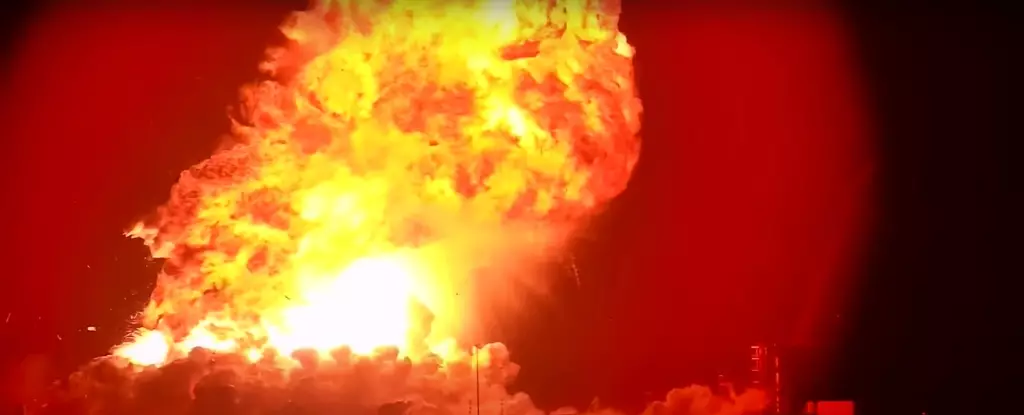In a dramatic turn of events that has become all too familiar in the realm of private space exploration, SpaceX’s Starship rocket met a fiery fate during a routine ground test at the company’s Texas launch facility. This incident underscores a crucial point: the path to innovation is riddled with peril, and as much as we applaud ambition, it’s essential to hold ourselves accountable for the consequences of that ambition. Elon Musk’s determination to colonize Mars is undeniably inspiring, yet we must scrutinize the implications of throwing caution to the wind in pursuit of such a lofty goal.
The explosion occurred during a static fire test, a pivotal moment meant to evaluate the rocket’s propulsion systems without actual liftoff. Yet, it quickly escalated from a controlled demonstration to a catastrophic event, erupting into a towering fireball that illuminated the night sky. While SpaceX assured the public that safety zones were in place, the reality remains that the “sudden energetic event” served as a stark reminder of the fragility underlying high-stakes aerospace endeavors. Each setback chips away at the narrative of invincibility that Musk has cultivated around SpaceX, and the world watches with a mixture of disbelief and concern.
Failures as Facilitators of Growth
SpaceX has famously adopted the “fail fast, learn fast” philosophy, aiming to expedite technological advancements through rapid iteration. However, this approach demands careful consideration of how many failures can be tolerated before the philosophy turns into a recklessness wrapped in bravado. The incident at Starbase isn’t an isolated setback; it follows a pattern littered with explosions and disintegrations of prototypes that, while instructive, also invite scrutiny into the efficacy of this methodology.
As Musk himself downplayed the event with an offhand remark, labeling it “just a scratch,” one has to question the cultural implications of such an attitude. Are we, as a society, valuing spectacle and ambition over safety and accountability? The juxtaposition between the profound aspirations of interplanetary colonization and the explosions rattling Texas serves to amplify concerns about prioritizing vision over the pragmatic intricacies of engineering.
A Double-Edged Sword of Public Sentiment
Public oversight and emotional investment in projects like SpaceX’s Martian ambitions can lead to an ambiguous sentiment. The excitement of groundbreaking human endeavors is tempered by the reality of repeated failures, which can sow fear and concern among cautious observers. Though Musk’s narrative paints a picture of fearless innovation, the collateral damage — in terms of safety standards, environmental concerns, and moral obligation — remains at the forefront of public discourse.
The recent approvals for increased launch frequencies by the Federal Aviation Administration (FAA) further complicate the picture. While the agency assured that the expansions would not adversely impact the environment, local communities and conservation groups are left navigating the murky waters of corporate responsibility versus ambitious athleticism in space exploration. The alarming sidelining of ecological considerations raises not just eyebrows but critical questions about who truly benefits from these grand experiments in outer space.
The Illusion of Steadfast Leadership
Despite repeated failures, SpaceX retains a formidable grip on public imagination. The company’s ability to recover swiftly from setbacks often leads to an impression of invulnerability. With NASA increasingly leaning on SpaceX for essential missions, there exists a paradoxical relationship between the need for innovation and the looming risk of catastrophic outcomes that often accompany rapid progress.
As Musk etches out plans for a Martian colony, one must ponder whether the space community and the general public are ready to confront the darker aspects of this audacious dream. Should we celebrate the boundless aspirations that propel humanity forward into the cosmos, or should we harbor a critical eye that demands accountability and pragmatism as we reach for the stars? The answer may not be so clear-cut, but the conversation has never been more necessary.
In an era where technological prowess often overshadows ethical considerations, the disability to maintain a critical perspective may lead us down a treacherous path. Are we willing to pay the price for cosmic ambitions with the very fabric of our safety and environmental stewardship? If we aspire to become an interplanetary species, we must first reckon with the consequences borne from the ignited engines of ambition and the explosive reality of our vulnerabilities.


Leave a Reply